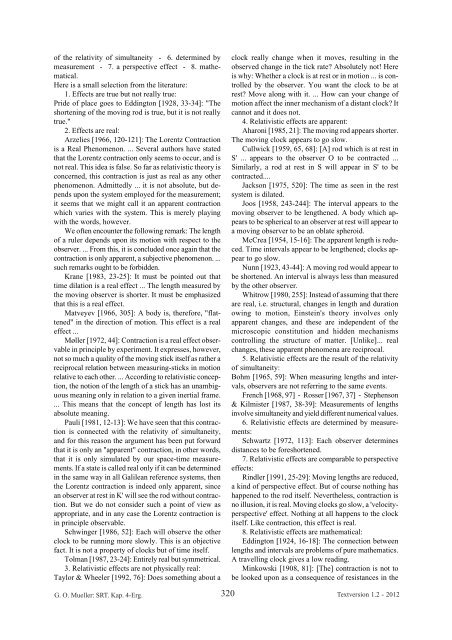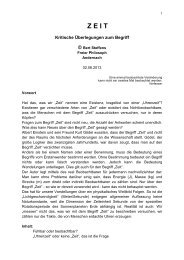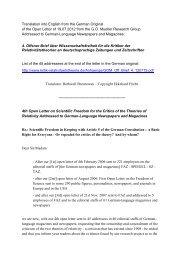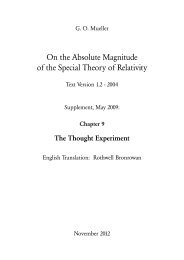2394 weitere kritische Veröffentlichungen - Kritische Stimmen zur ...
2394 weitere kritische Veröffentlichungen - Kritische Stimmen zur ...
2394 weitere kritische Veröffentlichungen - Kritische Stimmen zur ...
Sie wollen auch ein ePaper? Erhöhen Sie die Reichweite Ihrer Titel.
YUMPU macht aus Druck-PDFs automatisch weboptimierte ePaper, die Google liebt.
of the relativity of simultaneity - 6. determined by<br />
measurement - 7. a perspective effect - 8. mathematical.<br />
Here is a small selection from the literature:<br />
1. Effects are true but not really true:<br />
Pride of place goes to Eddington [1928, 33-34]: "The<br />
shortening of the moving rod is true, but it is not really<br />
true."<br />
2. Effects are real:<br />
Arzelies [1966, 120-121]: The Lorentz Contraction<br />
is a Real Phenomenon. ... Several authors have stated<br />
that the Lorentz contraction only seems to occur, and is<br />
not real. This idea is false. So far as relativistic theory is<br />
concerned, this contraction is just as real as any other<br />
phenomenon. Admittedly ... it is not absolute, but depends<br />
upon the system employed for the measurement;<br />
it seems that we might call it an apparent contraction<br />
which varies with the system. This is merely playing<br />
with the words, however.<br />
We often encounter the following remark: The length<br />
of a ruler depends upon its motion with respect to the<br />
observer. ... From this, it is concluded once again that the<br />
contraction is only apparent, a subjective phenomenon. ...<br />
such remarks ought to be forbidden.<br />
Krane [1983, 23-25]: It must be pointed out that<br />
time dilation is a real effect ... The length measured by<br />
the moving observer is shorter. It must be emphasized<br />
that this is a real effect.<br />
Matveyev [1966, 305]: A body is, therefore, "flattened"<br />
in the direction of motion. This effect is a real<br />
effect ...<br />
Møller [1972, 44]: Contraction is a real effect observable<br />
in principle by experiment. It expresses, however,<br />
not so much a quality of the moving stick itself as rather a<br />
reciprocal relation between measuring-sticks in motion<br />
relative to each other. ... According to relativistic conception,<br />
the notion of the length of a stick has an unambiguous<br />
meaning only in relation to a given inertial frame.<br />
... This means that the concept of length has lost its<br />
absolute meaning.<br />
Pauli [1981, 12-13]: We have seen that this contraction<br />
is connected with the relativity of simultaneity,<br />
and for this reason the argument has been put forward<br />
that it is only an "apparent" contraction, in other words,<br />
that it is only simulated by our space-time measurements.<br />
If a state is called real only if it can be determined<br />
in the same way in all Galilean reference systems, then<br />
the Lorentz contraction is indeed only apparent, since<br />
an observer at rest in K' will see the rod without contraction.<br />
But we do not consider such a point of view as<br />
appropriate, and in any case the Lorentz contraction is<br />
in principle observable.<br />
Schwinger [1986, 52]: Each will observe the other<br />
clock to be running more slowly. This is an objective<br />
fact. It is not a property of clocks but of time itself.<br />
Tolman [1987, 23-24]: Entirely real but symmetrical.<br />
3. Relativistic effects are not physically real:<br />
Taylor & Wheeler [1992, 76]: Does something about a<br />
G. O. Mueller: SRT. Kap. 4-Erg.<br />
320<br />
clock really change when it moves, resulting in the<br />
observed change in the tick rate? Absolutely not! Here<br />
is why: Whether a clock is at rest or in motion ... is controlled<br />
by the observer. You want the clock to be at<br />
rest? Move along with it. ... How can your change of<br />
motion affect the inner mechanism of a distant clock? It<br />
cannot and it does not.<br />
4. Relativistic effects are apparent:<br />
Aharoni [1985, 21]: The moving rod appears shorter.<br />
The moving clock appears to go slow.<br />
Cullwick [1959, 65, 68]: [A] rod which is at rest in<br />
S' ... appears to the observer O to be contracted ...<br />
Similarly, a rod at rest in S will appear in S' to be<br />
contracted....<br />
Jackson [1975, 520]: The time as seen in the rest<br />
system is dilated.<br />
Joos [1958, 243-244]: The interval appears to the<br />
moving observer to be lengthened. A body which appears<br />
to be spherical to an observer at rest will appear to<br />
a moving observer to be an oblate spheroid.<br />
McCrea [1954, 15-16]: The apparent length is reduced.<br />
Time intervals appear to be lengthened; clocks appear<br />
to go slow.<br />
Nunn [1923, 43-44]: A moving rod would appear to<br />
be shortened. An interval is always less than measured<br />
by the other observer.<br />
Whitrow [1980, 255]: Instead of assuming that there<br />
are real, i.e. structural, changes in length and duration<br />
owing to motion, Einstein's theory involves only<br />
apparent changes, and these are independent of the<br />
microscopic constitution and hidden mechanisms<br />
controlling the structure of matter. [Unlike]... real<br />
changes, these apparent phenomena are reciprocal.<br />
5. Relativistic effects are the result of the relativity<br />
of simultaneity:<br />
Bohm [1965, 59]: When measuring lengths and intervals,<br />
observers are not referring to the same events.<br />
French [1968, 97] - Rosser [1967, 37] - Stephenson<br />
& Kilmister [1987, 38-39]: Measurements of lengths<br />
involve simultaneity and yield different numerical values.<br />
6. Relativistic effects are determined by measurements:<br />
Schwartz [1972, 113]: Each observer determines<br />
distances to be foreshortened.<br />
7. Relativistic effects are comparable to perspective<br />
effects:<br />
Rindler [1991, 25-29]: Moving lengths are reduced,<br />
a kind of perspective effect. But of course nothing has<br />
happened to the rod itself. Nevertheless, contraction is<br />
no illusion, it is real. Moving clocks go slow, a 'velocityperspective'<br />
effect. Nothing at all happens to the clock<br />
itself. Like contraction, this effect is real.<br />
8. Relativistic effects are mathematical:<br />
Eddington [1924, 16-18]: The connection between<br />
lengths and intervals are problems of pure mathematics.<br />
A travelling clock gives a low reading.<br />
Minkowski [1908, 81]: [The] contraction is not to<br />
be looked upon as a consequence of resistances in the<br />
Textversion 1.2 - 2012





